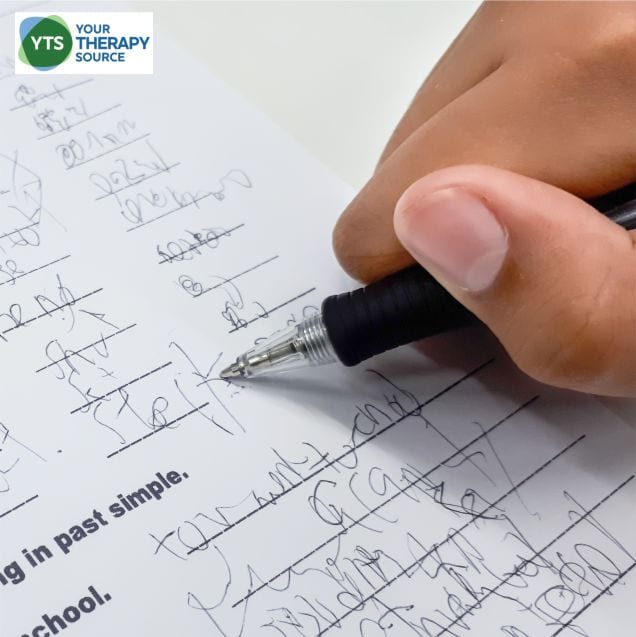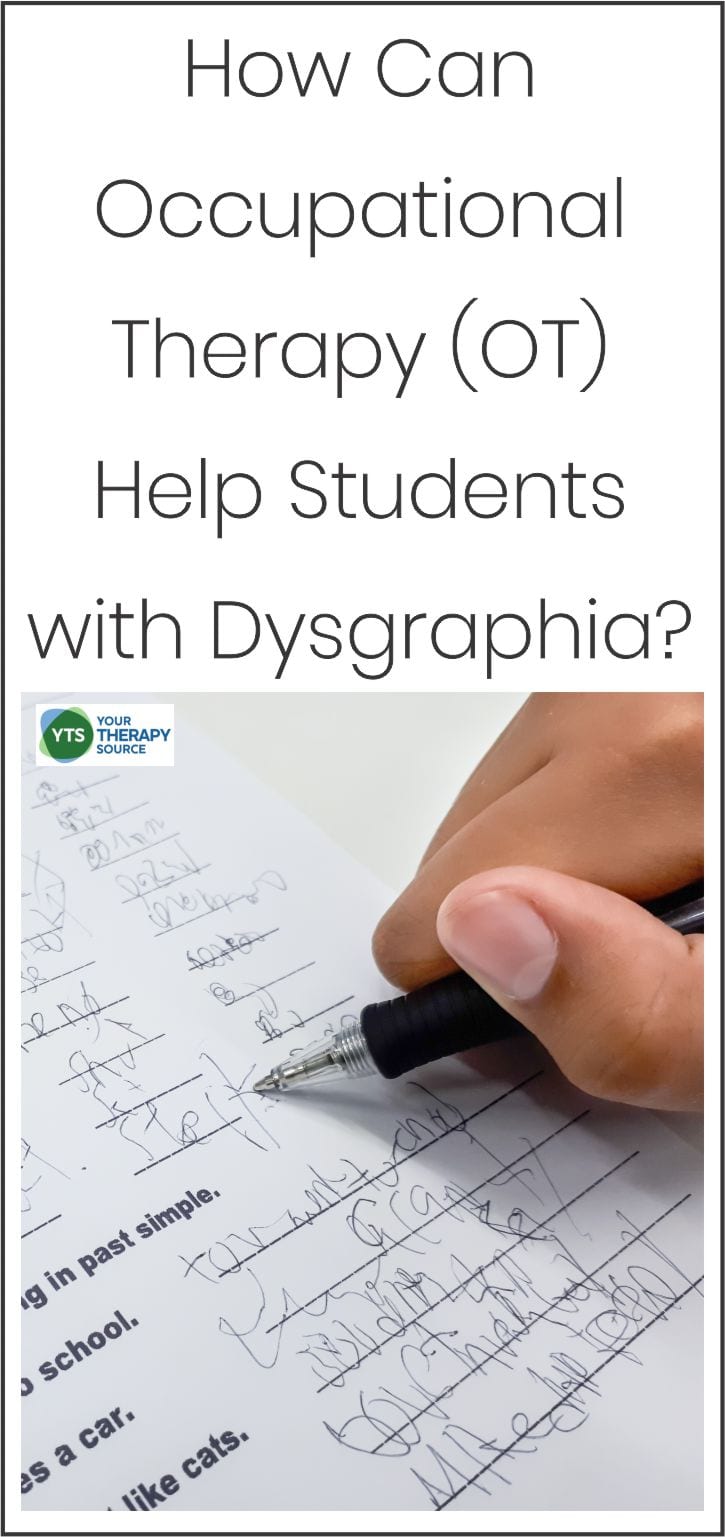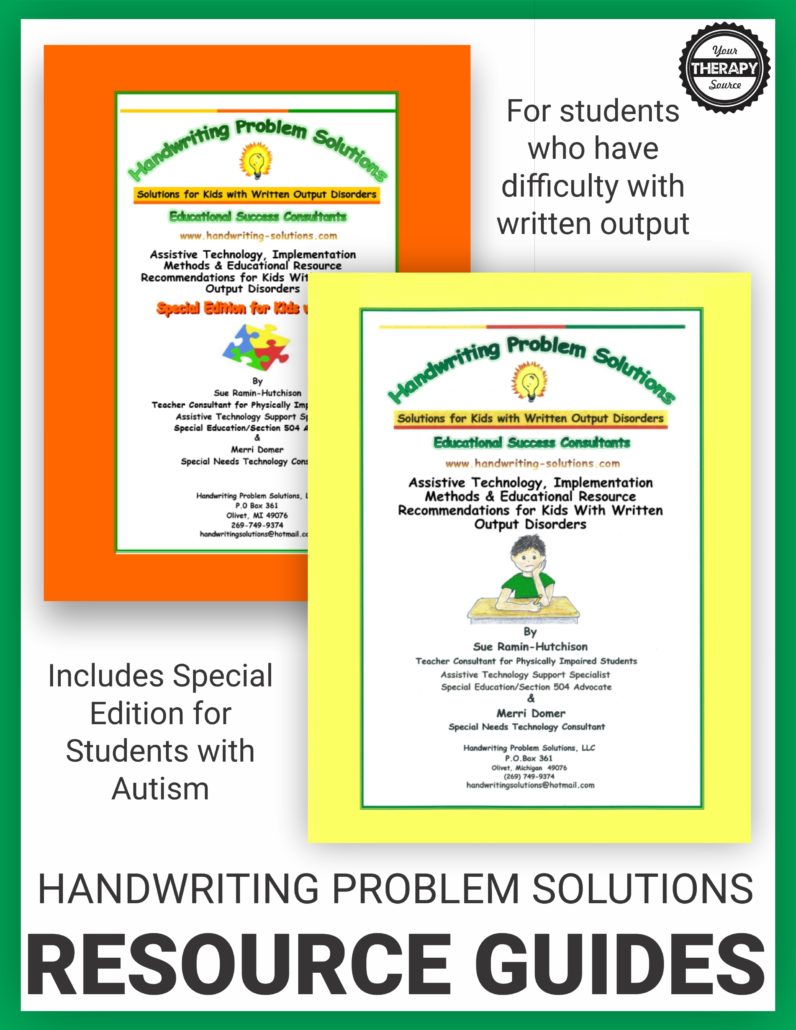How Can Occupational Therapy Help Students with Dysgraphia?

Are you a teacher who has students with dysgraphia? Perhaps you are an Occupational Therapist who receives referrals for students with dysgraphia? Maybe you are a parent wondering how can occupational therapy help students with dysgraphia?
The first steps in helping students who struggle with handwriting
When a student shows signs of struggling with handwriting the first step is usually the response to intervention phase where different strategies are tried with all the students in the class to improve handwriting skills. If this is not effective for a particular student, a more intensive intervention may occur such as additional handwriting instruction or practice time. Moving along a continuum of interventions, if handwriting struggles continue a referral may be made for an Occupational Therapy evaluation. (Keep in mind this continuum varies from district to district).
The Occupational Therapy evaluation results and recommendations
Once the occupational therapy evaluation has been completed, OT services may be recommended if the students shows deficits in the building blocks that are necessary for legible and efficient handwriting. Occupational therapist may work on fine motor skills, muscle strength in the hands, shoulders and trunk, and visual perceptual skills to help improve handwriting skills. Interventions should be closely monitored to determine if handwriting improves.
It is important to remember that some younger students may simply need more handwriting practice time and not direct occupational therapy services.
What should you to do if the interventions are not helping with handwriting?
We asked two assistive technology specialists, Sue Ramin-Hutchison (Certified Teacher Consultant for Physically & Otherwise Health Impaired Students, Assistive Technology Support Specialist and Special Education/Section 504 Advocate) and Merri Domer (Special Needs Technology Consultant), what to do if after interventions a student is still struggling with handwriting or is diagnosed with dysgraphia.
Ms. Ramin-Hutchison and Ms. Domer responded that when occupational therapy is not enough to help improve a student’s handwriting in a way that is LEGIBLE, TIMELY and NOT STRESSFUL for the student, Assistive Technology (AT) should be considered. If one or more of these 3 key things (legibility, speed and stress level) continues to be a significant problem for a student when it comes to handwriting, Assistive Technology for assignment completion should be considered, taught and implemented.
At what age should you start with assistive technology for writing?
Some students may need to start learning to use AT as early as kindergarten (i.e. students with some types of physical impairments, ADD/ADHD and ASD), while some students can “muddle through” and use their handwriting through the beginning of 3rd grade or so. Many times, these students are receiving OT to work on improving their handwriting skills.
If a student is still struggling with handwriting skills by mid-3rd grade and has been receiving OT for 1-2 years with minimal to no handwriting improvement, this is the time when Ms. Ramin-Hutchison and Ms. Domer believe that OT should be discontinued and the use of AT should be taught and implemented. There is a HUGE increase in the amount of written work in 4th grade and beyond and these students need to be ready to meet this need “head on.” Time and time again, they see professionals wait much too long to consider the use of AT for these students, which is so detrimental to their well-being in just about every way. If professionals wait too long to recognize that these kids need to use AT, they are putting them at great risk for future, academic, emotional and behavioral failure.
The great news is that these students can be SO successful in the classroom using the latest “best practice” AT to complete the exact same assignments as their peers, even advanced math and science! The majority of this AT is now very cost effective and easy to learn to use
How to help if a student does need assistive technology
When it is determined by school staff that the use of AT for assignment completion should be taught and implemented for students, many times Occupational Therapists, in the US, often take on the role of instructing the students how to use the AT.
It is very important for OTs and other school staff to know that the use of AT, in many cases, does not mean that students should abandon their handwriting skills altogether. Once again, they should use LEGIBILITY, TIMELINESS AND STRESS LEVEL as the 3 key things to consider as to when to teach and implement the use of AT. If one or more of these key things is a significant issue for students, AT should be used. If not, the student can use their handwriting.
Many students with educationally significant handwriting challenges CAN use their handwriting for some things. BUT, it is extremely important that it be specifically structured by the school staff as to when a student uses AT and when they can use their handwriting.
This should be “teacher directed, and teacher expected” and NOT left up to the student to decide.
If this is not done and strictly adhered to, there is a very high likelihood that the AT will end up “on the shelf” and the student will continue to be more and more at risk every year.
Tips from the Trenches
Ms. Ramin-Hutchison and Ms. Domer have worked with many OTs in the past in multiple Michigan school districts as well as nationally and internationally through their website. They have found that sometimes OTs need additional training as to what AT is “best practice.”
Much of the information about this on the internet is not current and can actually be very out of date. Even if it IS current, it can be very difficult and frustrating to know what AT is best for both the students and the school staff that work with them.
In their experience, they have found that working on traditional keyboarding skills can be very difficult, or impossible, for many of these students to learn due to their fine motor and/or attentional deficits.
In addition, they have found teaching students how to use voice recognition is NOT the best first choice for almost all students. Voice recognition does not support spelling skills, it cannot be used in multiple environments and it cannot be used for standardized testing, among other things. It also does not address the need for students to be able to complete worksheets and math.
They have developed an adapted method of keyboarding that can be easily taught to kids of all ages and they can be “up and running” in the classroom typing their assignments, often in 8 weeks or less. This method has been used in special needs schools in different areas of the US and the OTs have been amazed on how easy it is to teach and how quickly and well it works!
Resources to Help Students with Dysgraphia
The resource guides, Assistive Technology, Implementation Methods & Educational Resource Recommendations for Kids with Written Output Disorders and our Special Edition for Kids with ASD, have been created to help OTs, other professional and parents take the “guesswork” out of trying to decide what really is “best practice” AT for kids with written output disorders – as well as how to teach their method of adapted keyboarding and the best ways to implement this AT in the classroom. Purchasers of the Guides are also given the access information to the “Guide Updates” page on their website where they are continually posting new information about AT for kids with written output disorders as it becomes available. This always keeps the guides current and up to date. FIND OUT MORE.
RELATED POSTS
Types of Dysgraphia – Symptoms and How to Help – Sue Ramin-Hutchison (Certified Teacher Consultant for Physically & Otherwise Health Impaired Students, Assistive Technology Support Specialist and Special Education/Section 504 Advocate) and Merri Domer (Special Needs Technology Consultant), have compiled helpful information on the types of dysgraphia, symptoms and how to help.
Dysgraphia, DCD, and Reading Disorders





